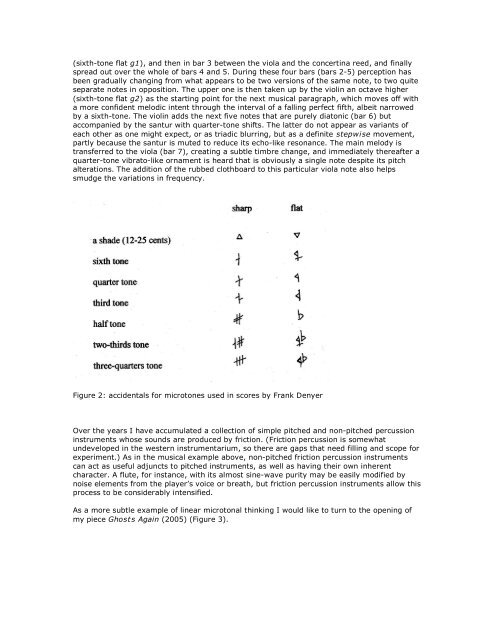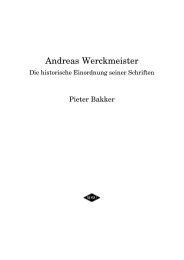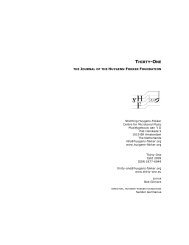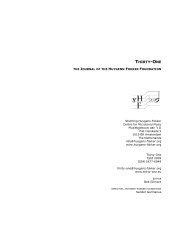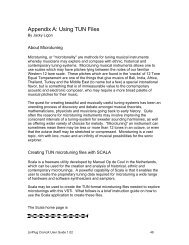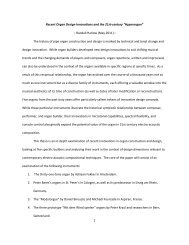Some Thoughts on Linear Microtonality - Frank Denyer - Stichting ...
Some Thoughts on Linear Microtonality - Frank Denyer - Stichting ...
Some Thoughts on Linear Microtonality - Frank Denyer - Stichting ...
You also want an ePaper? Increase the reach of your titles
YUMPU automatically turns print PDFs into web optimized ePapers that Google loves.
(sixth-t<strong>on</strong>e flat g1), and then in bar 3 between the viola and the c<strong>on</strong>certina reed, and finallyspread out over the whole of bars 4 and 5. During these four bars (bars 2-5) percepti<strong>on</strong> hasbeen gradually changing from what appears to be two versi<strong>on</strong>s of the same note, to two quiteseparate notes in oppositi<strong>on</strong>. The upper <strong>on</strong>e is then taken up by the violin an octave higher(sixth-t<strong>on</strong>e flat g2) as the starting point for the next musical paragraph, which moves off witha more c<strong>on</strong>fident melodic intent through the interval of a falling perfect fifth, albeit narrowedby a sixth-t<strong>on</strong>e. The violin adds the next five notes that are purely diat<strong>on</strong>ic (bar 6) butaccompanied by the santur with quarter-t<strong>on</strong>e shifts. The latter do not appear as variants ofeach other as <strong>on</strong>e might expect, or as triadic blurring, but as a definite stepwise movement,partly because the santur is muted to reduce its echo-like res<strong>on</strong>ance. The main melody istransferred to the viola (bar 7), creating a subtle timbre change, and immediately thereafter aquarter-t<strong>on</strong>e vibrato-like ornament is heard that is obviously a single note despite its pitchalterati<strong>on</strong>s. The additi<strong>on</strong> of the rubbed clothboard to this particular viola note also helpssmudge the variati<strong>on</strong>s in frequency.Figure 2: accidentals for microt<strong>on</strong>es used in scores by <strong>Frank</strong> <strong>Denyer</strong>Over the years I have accumulated a collecti<strong>on</strong> of simple pitched and n<strong>on</strong>-pitched percussi<strong>on</strong>instruments whose sounds are produced by fricti<strong>on</strong>. (Fricti<strong>on</strong> percussi<strong>on</strong> is somewhatundeveloped in the western instrumentarium, so there are gaps that need filling and scope forexperiment.) As in the musical example above, n<strong>on</strong>-pitched fricti<strong>on</strong> percussi<strong>on</strong> instrumentscan act as useful adjuncts to pitched instruments, as well as having their own inherentcharacter. A flute, for instance, with its almost sine-wave purity may be easily modified bynoise elements from the player’s voice or breath, but fricti<strong>on</strong> percussi<strong>on</strong> instruments allow thisprocess to be c<strong>on</strong>siderably intensified.As a more subtle example of linear microt<strong>on</strong>al thinking I would like to turn to the opening ofmy piece Ghosts Again (2005) (Figure 3).


